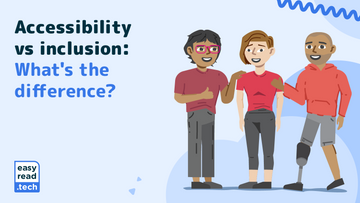Accessibility vs inclusion: What's the difference?

Illustration by Justin Olivares.
Accessibility is being invited to the party. Inclusion is being asked to dance.
- Professor Richard Bruggemann, disability advocate, at the launch of easyread.tech, 28th November 2023
The terms ‘accessibility’ and ‘inclusion’ are often used interchangeably, or clumped together when referring to the holistic concept of making practices more welcome to diverse individuals. However, it is important to note that these terms do not mean the same thing, as well as the fact that accessibility and inclusion, respectively, look very different in different contexts.
Accessibility: Breaking down barriers
Accessibility, when talking about people with disabilities, is the idea that people with disabilities are given equal opportunity to access, participate in and engage with opportunities, services, information and other facets of public life, in the same way that people without disabilities can. This may mean providing additional accommodations, or modifying existing structures, whether physical or digital, to ensure that people with disabilities are not excluded.
Some practical examples of accessibility include:
- Websites that feature or facilitate assistive technologies (i.e. screen readers or voice commands) to benefit users who rely on assistive technologies to help navigate digital platforms
- Modified infrastructure for people with disabilities (i.e. ramps, braille signage or accessible parking spaces)
- Easy Read or Plain English resources that are relevant to people with intellectual disabilities, cognitive decline or low literacy
Inclusion: Fostering a sense of belonging
Inclusion refers to the concept that people with disabilities are involved, engaged and included in the environment they are in. Inclusion is a much broader concept than accessibility and transcends mere physical and digital accommodations (although making accommodations can greatly contribute to setting a culture of inclusion).
Let’s compare the pair.
If accessibility is ensuring that people with disabilities have the right tools and augmentations to contribute effectively to their institution or community, then inclusion is about making sure that the environment and the culture surrounding those tools are welcoming, equitable and safe.
If accessibility means making positive changes to enhance the lives of people with disabilities, then inclusion is setting the standard so that people with disabilities are comfortable to speak up about the arrangements they need that benefit their lives.
If accessibility means giving people with disabilities the supports they need to join the conversation, then inclusion is the initial conversation that recognised the need to commit to including people with disabilities.
Furthermore, while accessibility may be a legal standard, inclusion is a culture determined by the actions and attitudes of the people within the ecosystem.
Going back to Richard Bruggeman’s example: accessibility is ensuring that your friend who uses a wheelchair can enter the house by setting up a ramp, and spacing the chairs further apart so they can move between them comfortably. Accessibility may also be designating a specific quiet place for your friend who experiences sensory overload. Meanwhile, inclusion is about inviting your friends with a disability to the party in the first place, rather than excluding them, and being mindful of any accommodations needed for them to enjoy the party like everyone else. Inclusion can also mean letting your friends with disabilities know that they can reach out to you if they need anything during the night and addressing their needs with understanding and support.
While accessibility may be a legal standard, inclusion is a culture determined by the actions and attitudes of the people within the ecosystem.
Overall, the distinction between accessibility and inclusion is a nuanced one, but understanding the difference will go a long way in making sure any efforts to make your environment, whether that be your workplace, home, community or society in general, are comprehensive and effective
easyread.tech is committed to the mission to make information accessible for all through Easy Read and Plain English formats, and change the culture of information and communications to be more inclusive and applicable to all. Reach out to us and take the first step in making your organisation more accessible and inclusive.
